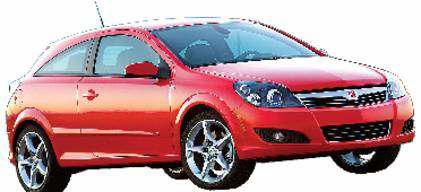Saturn Ion is out, Astra is in
Published 5:00 am Sunday, June 1, 2008

- The 2008 Saturn Astra is a compact car — this one’s three-door — with decent fuel economy, attractive styling and, of all things, a European flair.
Get behind the wheel of the lowest-priced 2008 Saturn Astra and you’ll notice such European cues as firmly supportive seats, thick steering wheel, different style of radio controls, exemplary steering and competent handling.
And that’s before you check out the window sticker that tells you the Astra is built in Belgium, has an engine from Hungary, a transmission from Austria and more than a third of its parts from Germany.
Saturn’s newest model was engineered in Germany as an Opel car and comes to the States with relatively few changes. Saturn’s last entry-level car, the Ion, was widely critiqued as a disappointment. As Ion’s replacement for 2008, the Astra is virtually the same car that Opel has been selling in Europe for about four years — hence the European flair.
Best of all, the Astra’s starting manufacturer’s suggested retail price, including destination and delivery charge, is $16,495 for a 2008 five-door XE model with 138-horsepower, four-cylinder engine, manual transmission and no air conditioning. The starting retail price with an automatic transmission is $17,820.
These prices compare with the 2008 Volkswagen Rabbit hatchback from Europe, whose starting MSRP, including destination charge, is $16,250 with manual transmission and air conditioning, and the 2008 Mazda3 hatchback from Japan, which starts at $18,675 with manual and air conditioning.
To be sure, Americans haven’t been crazy about hatchback cars in decades, preferring sedans that often look pricier and can be roomier.
But the Astra, with nicely placed shiny silver accents outside, commendable materials inside and a pleasing shape, looks pricier than it is. And with both three- and five-door models having the same 14.2-foot length from end to end, there’s acceptable room inside, even in the back seat with its 35 inches of legroom, which is about the same as in a five-door Rabbit.
The 38.3 inches of headroom in the back seat of the Astra five-door also is about on par with that of the Rabbit’s.
Cargo space in the Astra is helped by a low cargo floor, resulting in 12 cubic feet or so with the rear seats in use and more than 37 cubic feet with the rear seatbacks down.
All Astras get the same 1.8-liter, double overhead cam, four-cylinder engine with variable valve timing that works for both intake and exhaust.
This isn’t a particularly peppy engine when the Astra — about the same size as Ion — is loaded with people and luggage. Torque peaks at 125 foot-pounds at 3,800 rpm. But it’s an OK compromise in a car that weighs less than 3,000 pounds and gets better gas mileage than a VW Rabbit. (The Rabbit has a 2.5-liter, inline five cylinder generating more horsepower — 170 — and more torque — 177 foot-pounds at 4,250 rpm.)
The Mazda3 offers more power, too, with its uplevel four cylinder that produces 156 horsepower and 150 foot-pounds at 4,500 rpm. But fuel mileage suffers as a result.
The test Astra — a three-door XR — got the most out of its engine via a five-speed manual, though the engine got buzzy when pressed.
Saturn offers an automatic tranny, but it has only four gears and fuel economy drops from the manual’s 24 miles per gallon in city driving and 32 mpg on the highway to 24/30 mpg.
During my test drive, with a majority of the driving done in the city, the Astra managed nearly 25 mpg. Regular unleaded is just fine in the Astra, and the gas tank holds 11.9 gallons for a range of just over 300 miles.
The Astra is front-wheel drive, with the usual front-drive-car understeer when it’s driven aggressively in corners.
But there was nothing unsettling about the test Astra’s road manners, and combined with good brake pedal feel, a steady feel of the road through the steering and nicely matched, 17-inch all-season performance tires, the Astra was nimble and enjoyable to drive.
I noticed some wind noise at highway speeds along the driver door of the test car. But with the Astra’s body being all metal, not plastic panels like those on the predecessor Saturn small car, the Ion, there’s far less wind noise as the gaps between the body panels now are much smaller and akin to those on other cars.
The thick body pillars around the rear window can obscure views as a driver backs out of parking spaces, and the radio controls require some deciphering.
Saturn doesn’t offer a typical, large-display screen navigation system for the Astra.
But the car does have a nice feature from Europe — a blinker stalk that requires just a little push to blink three times and then stop for those times a driver is merely moving from one lane to another.
Other standard features on all models include six air bags, antilock brakes, anti-whiplash front head restraints, AM/FM stereo with six speakers and a CD player, cruise control, power windows, doors and outside mirrors, manual-adjusting front seats and floor mats.
Also worth mentioning for drivers in cold climates: The Astra is one of the few cars on the market that offers heated seats with cloth upholstery. Most models require leather-covered, heated seats.
OnStar emergency notification comes standard, too.
But electronic stability control is an option on all but the three-door XR.
The Astra has been sold in Europe since 2004. Saturn’s previous small car, the Ion, was dropped from the lineup after the 2007 model year.
2008 Saturn Astra
Type: Front-engine, front-wheel drive, five-passenger, compact hatchback
Base price: $15,875 for five-door XE; $17,425 for five-door XR; $18,375 for three-door XR
As tested: $19,590
Engine: 1.8-liter, double overhead cam four cylinder with variable valve timing.
Mileage: 24 mpg (city), 32 mpg (highway)
Top speed: 129 mph
Built in: Belgium
Options: Audio package (includes enhanced driver information center, AM/FM stereo with six-CD player and premium speakers) $595






